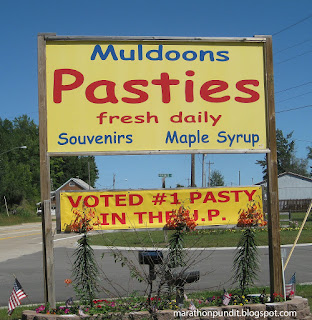That sojourn gave me the opportunity to enjoy the Quincy Mining Company Historic District, which is just north of Hancock. It's part of the Keweenaw National Historical Park, which is on US Route 41 just north of Hancock.
That's the #2 Shafthouse straight ahead with one of the site's many ruins on the right.
Ah, but what is this? North of Quincy Mine is the unincorporated village of Mohawk and the Mohawk Snow Stick.
The Keweenaw is 50 miles long and 15 miles wide, it juts out into Lake Superior. As colder air comes in contact with slightly warmer lake water, it produces lake effect snow. The all-time record for snowfall there is 390.4 inches--32 feet--which is believed to be the highest snow accumulation in the United States east of the Rocky Mountains.
Yes, the winters are brutal there.
So far 304 inches of snow have fallen in the winter of 2017-18.
Here's a closer look at those decayed buildings in front of the shafthouse.
The Quincy Mine opened in 1846 as the U.P. copper boom, America's first, was starting. It closed in 1931 but reopened for a spell during World War II, shutting down for good in 1945. From 1862 until 1882 it was America' most productive copper mine.
Some of the early investors were from Massachusetts, they named the mine after Quincy, a town south of Boston, where John Adams and John Quincy Adams were born.
Copper mining was not new to Keweenaw, 7,000 years ago Native American mined copper there.
Over on the other side of US 41 there are more ruins.
Mining dryhouses--this is all that remains of the one at Quincy--were locker rooms with sinks, a place to wash up and change in and out of work clothes.
Here's a close up of the dryhouse.
Wild sweet peas, brought to Keweenaw by immigrant miners, flourish on the peninsula. They're common in Detroit too.
Invasive? Yes. Beautiful? That too.
Experienced miners from Cornwall, England brought their expertise to Keweenaw. Michigan copper mining quickly surpassed those of Cornwall. The only remaining copper mine on the Upper Peninsulas is the four-year-old Eagle Mine near Marquette.
Cornwall's last mine of any type shuttered in 1998.
The Cornish brought pasties, a meat and vegetable-filled pastry, which are similar to pierogis, to the Upper Peninsula, where they are still widely available.
Pasty rhymes with "nasty."
This photograph was taken in 2009 in Munising.
Basalt fieldstone was used for many of these structures. Basalt is an igneous rock, fieldstone, is well, rocks just lying around, or in the case of mining areas, it's waste rock.
Ironically, fieldstone buildings are common in Massachusetts and the rest of New England.
Here you'll see the Number 2 Hoist House (left) and Old No 2 Hoist House, the last one is now the visitors center, where Mrs. Marathon Pundit spent most of her time while I was taking pics--it has a strong Wi-Fi signal. Urban exploration, even in a rural area, isn't a chick thing. As for myself, I suffered through The Vow with her at one of those expensive movie theaters where you can order dinner. Fortunately for everyone else at the show, I ate lightly and I was able to keep my food down.
Nice digs, right? This is what a typical miner's home looked like.
Cow vetch is another European invader that I found at Quincy Mine.
Here's an outlier, a sandstone structure.
"But man in feeble, man is puny," Elvis Costello sang in "Red Cotton."
And so are man's creations.
The Quincy and Torch Lake Railroad once hauled copper out of the Upper Peninsula.
Nature always wins in the end.
Related post:
(Photos) Gay, Michigan



















No comments:
Post a Comment